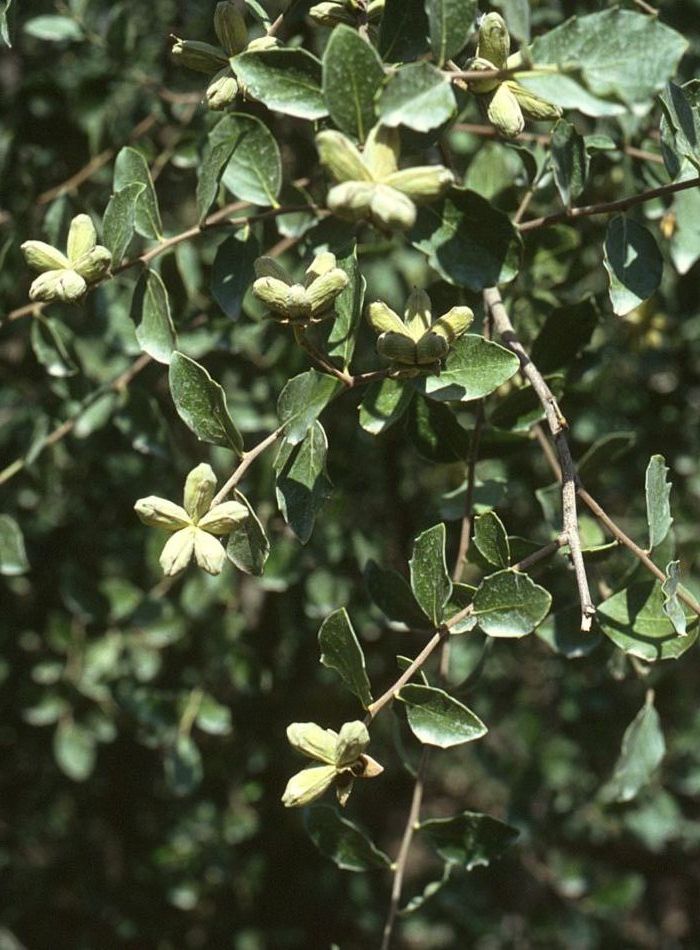- Quillaja saponaria
Taxobox
name = Soap bark tree

regnum =Plant ae
divisio =Magnoliophyta
classis =Magnoliopsida
ordo =Fabales
familia =Quillajaceae
genus = "Quillaja "
species = "Q. saponaria"
binomial = "Quillaja saponaria"
binomial_authority = MolinaThe Soap bark tree or Soapbark ("Quillaja saponaria") is an evergreen
tree in the familyQuillajaceae , native to warm temperate centralChile north toPeru . In Chile it occurs from 32 to 40° South Latitude approximately. Populations are found even 2000 m (6500 ft) above sea level. It can grow to 15-20 m (50-65 ft) in height. The tree has thick, dark bark, smooth, leathery, shiny, ovalevergreen leaves 3-5 cm long, whiteflower s 15 mm diameter borne in densecorymb s, and a dryfruit with five follicles each containing 10-20seed s.The inner bark of "Quillaja saponaria" can be reduced to powder and employed as a substitute for
soap , since it forms a lather with water, owing to the presence of aglucoside saponin , sometimes distinguished asquillaia saponin. It also applied as an agricultural spray adjuvant. The same, or a closely similar substance, is found in soapwort ("Saponaria officinalis "), in senega root ("Polygala senega") and insarsaparilla ; it appears to be chemically related todigitonin , which occurs in "digitalis ".Soap bark tree has a long history of medicinal use with the Andean people who used it especially as a treatment for various chest problems. It is the source of
quillaia , the extract of which is used as afood additive and as an ingredient inpharmaceutical s, personal care products, and fire-fighting foam. It is used as additive for photographic films and foaming for drinks. The saponin content of the bark helps to stimulate the production of a more fluidmucous in the airways, thus facilitating the removal ofphlegm through coughing. The saponins of this tree are also considered to haveadjuvant properties forvaccine solutions.The plant is drought resistant, and tolerates about -12°C (10°F) in its natural habitat [Taylor. J. 1990. The Milder Garden. Dent. A good book on plants that you didn't know could be grown outdoors in Britain.] . It is often used for
reforestation onarid soil s. It has been introduced as an ornamental inCalifornia . Trees have been acclimatized inSpain but are rarely cultivated there.The wood is used cabinetry, and scents derived from the tree are used in perfumes and cosmetics.References and External links
*Donoso, C. 2005. Árboles nativos de Chile. Guía de reconocimiento. Edición 4. Marisa Cuneo Ediciones, Valdivia, Chile. 136p.
*Hoffmann, Adriana 1998. Flora Silvestre de Chile, Zona Central. Edición 4. Fundación Claudio Gay, Santiago. 254p.
* [http://www.florachilena.cl/Niv_tax/Angiospermas/Ordenes/Fabales/Quillajaceae/Quillay.htm "Quillaja saponaria" in Encyclopedia of the Chilean Flora]
* [http://www.chilebosque.cl/tree/qsapo.html "Quillaja saponaria" pictures from "Chilebosque"]
*Köhler's Medicinal Plants
* [http://www.jardibotanic.bcn.es/22_8_eng.htm"Quillaja saponaria" in Barcelona, Catalonya, Spain]
* [http://www.drugs.com/npp/quillaja.html"Soapbark tree" widely cultivated in California and Chemical benefits]
Wikimedia Foundation. 2010.
